Magnolia is our first Plant of the Month for 2022. These early blooming trees and large shrubs come in a variety of flower colors, sizes, and hardiness. The flowers on magnolias are well known for their fragrance, and in Northeast Kansas, for being caught by late spring freezes. Even with the hardiness of the flower issue, we keep planting these in our gardens.
There are 15 species of magnolia native the the eastern United States, mostly south and east of the Ohio River. Most of the current available hybrid magnolias are crosses between just a few species. Cultivars can also stem from a few well known species.
The very name magnolia often puts people in mind of the south. Georgia, Alabama, and Mississippi have 6 species native to all 3 states. These trees like the heat of the south and rarity of late spring freezes. What do you think of when you hear the word magnolia? I think of the double pink blossoms of the ‘Leonard Messel’ magnolia in my garden. Let us look at the different species and some of the more prominent cultivars.
Native Magnolias
Cucumber Tree – M. acuminata
This large and deciduous magnolia is native to the eastern and southeastern United States. It is the only species native to Missouri. Hardy in zones 3 to 8, cucumber tree can be successfully grown in Kansas and the Central Great Plains region, though I have seen only a few. They prefer well-drained, moist soils, but are fairly adaptable to landscape soils.
The flowers of the cucumber tree are 2 to 4 inches long, greenish-yellow, and fragrant. The tree grows 40 to 70 feet tall by 30 to 40 feet wide. However, larger specimens can be found. Unlike many other magnolias, the cucumber tree has reliable yellow fall color. Because the flowers are not as showy as other species, it often does not appear in nurseries.
Several cultivars come from crosses made with M. acuminata as a dominant parent.
- ‘Butterflies‘ is a well-known, yellow flowering cultivar. It grows 18 to 20 feet tall and wide.
- ‘Elizabeth’ is a taller, yellow flowered hybrid, growing 40 feet tall and wide.

Southern Magnolia – M. grandiflora
This is a large, evergreen magnolia tree, that is hardy in Zones 7 to 9. It can be grown in the southern edge of the Central Great Plains, such as southern Kansas and Missouri. I have seen nice specimens even in Kansas City. This species is well known for its large, dark green leaves, and very showy flowers.
Southern magnolia grows 60 to 80 feet tall by 40 to 60 feet wide. And even bigger specimens can be found in the Southeast. One of the things I love about this tree, though I cannot grow it, is the showy and fragrant flowers. They are later blooming than species I can grow, blooming May and June – well after frost has passed.
Moist and deep soils are the best places for this tree, but they are adaptable to landscape use, especially where irrigation is used. One cultivar, ‘Bracken’s Brown Beauty’, is more cold hardy, to Zone 6. We grew one here at Grimm’s Garden for several years before it had to be removed for our shop expansion.
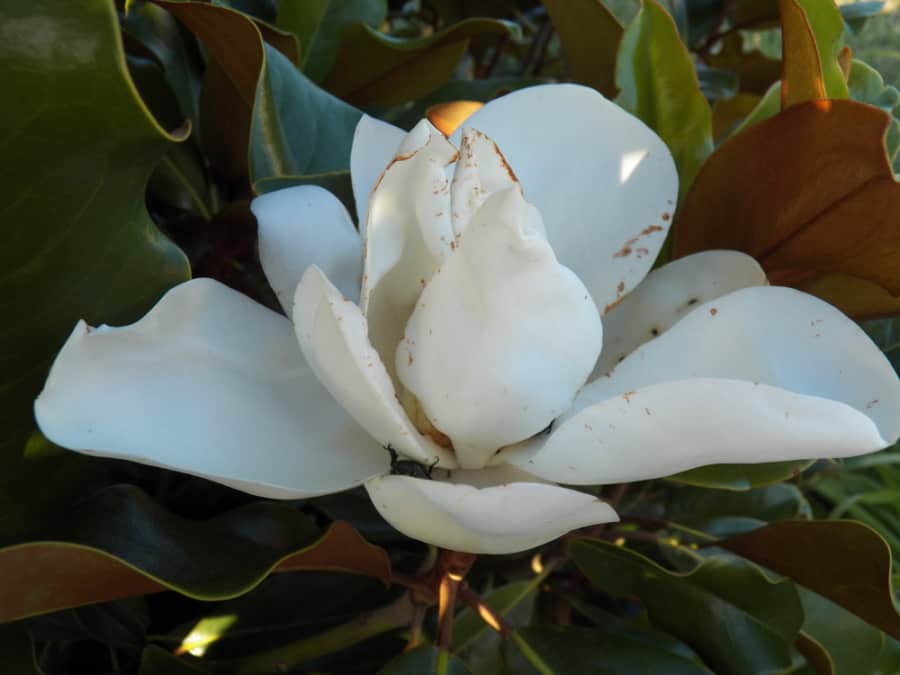
Bigleaf Magnolia – M. macrophylla
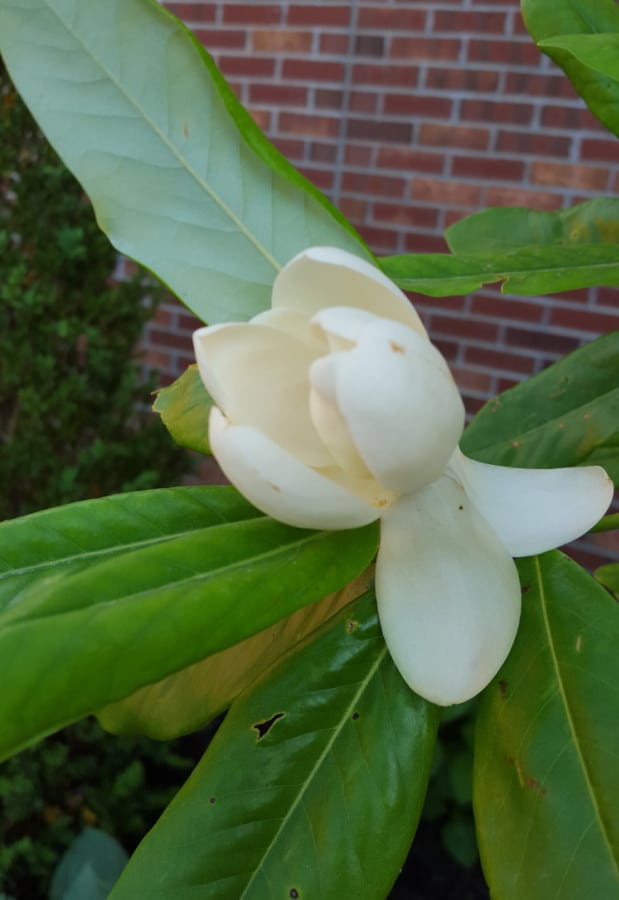
Hardy in Zones 5 to 8, I can grow this species here in my own gardens. This tree is a smaller species, growing 40 feet tall and wide. But it has the largest and most tropical looking leaves. The flowers are large, cream-white, and very fragrant. However, there are few cultivars available, and most plants are seed grown in nurseries.
Sweetbay – M. virginiana
This species is hardy in Zones 5 to 8, so I may try growing one in my garden. It is deciduous or partly evergreen, depending on location. Also, it is a smaller tree, growing 35 feet tall and wide. Tolerant of clay and wet soils, it may be the easiest to grow out of its native range.
There are many cultivars of sweetbay in the nursery trade, for different sizes, flowers, and even leaf variegation.
- ‘Henry Hicks’ is possibly the hardiest of the sweetbays, not losing a leaf at -24 oF
- ‘Mardi Gras’ has variegated leaves and a smaller habit 20 feet tall and 15 feet wide. Less hardy, it needs to be grown in Zones 7 to 9.
- ‘Moonglow’ has creamy white flowers and grows 40 feet tall by 18 feet wide. Hardy to -24 oF
Hybrid and Non-Native Magnolias
Besides the magnolias of North America, there are several species from Asia, which are used for hybridization and select cultivars. Some of these are considered invasive in certain places of the U.S.
Loebner Magnolia – M. x loebneri
This is a widely used hybrid, developed by Max Loebner of Germany, before WWI. It is a cross between M. kobus and M. stellata. Some of the best cultivars come from this hybrid. The original hybrid grows 30 feet tall and wide. while many of the selections are smaller. These hybrids are very tolerant of high pH soils, and hardy in Zones (4)5 to 8, making them excellent selections for the Central Great Plains region.
- ‘Leonard Messel‘ is my favorite cultivar of all the magnolias. It has fragrant, double pink blossoms that usually miss the later spring frost. The habit is upright, growing 15 to 20 feet tall and 10 feet wide. Also, it has good yellow to almost orange fall color.
- ‘Merrill‘ is a another great cultivar of this hybrid, with single, white blossoms. It grows larger, 30 feet tall and wide.
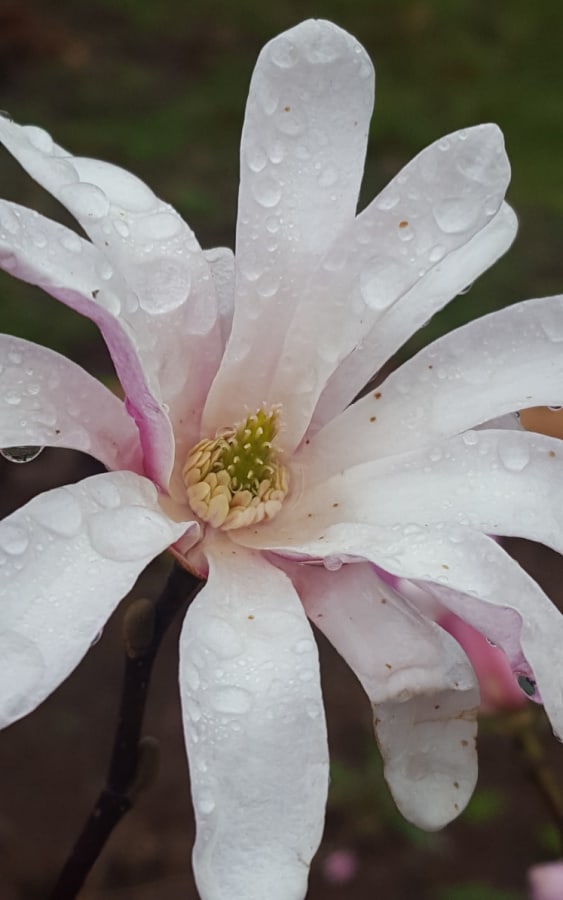
Saucer Magnolia – M. x soulangiana
The saucer magnolia was the first of the species that I ever learned of, seeing it blooming in my grandmother’s garden. That garden is what helped make me into the plantsman I am today. Also, I discovered the Nebraska State Champion Saucer Magnolia in Falls City, NE just a few years ago. These are larger trees, growing 40 feet tall and wide, with larger specimens.
This hybrid was created in the early 1800s in France, by a French soldier. Here in Northeast Kansas, many of our saucer magnolias are the first to bloom, and they often get hit by late freezes and frosts. But some years, we get a spectacular floral display. Besides the original hybrid itself, there are several cultivars selected.
- ‘Rustica Rubra‘ is one of our best-selling magnolias here at Grimm’s Gardens. It has rose red flowers and grows 20 feet tall and wide.
- ‘Black Tulip‘ is a smaller selection which has dark red blossoms and grows 20 feet tall by 10 feet wide.
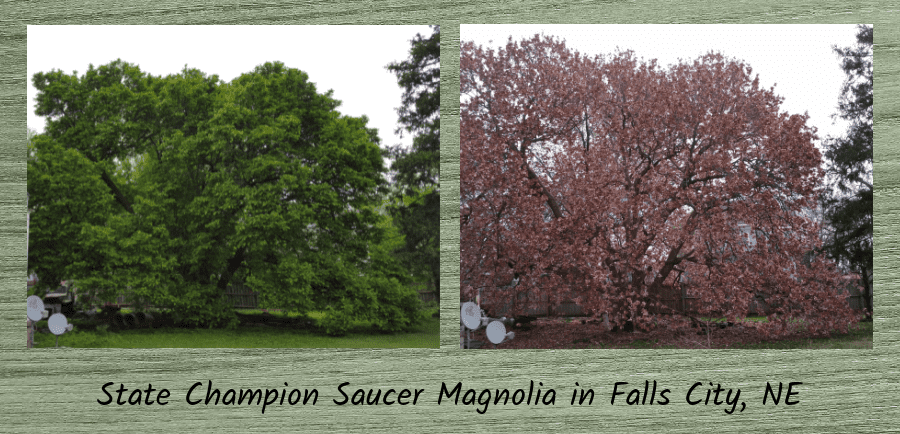
Star Magnolia – M. stellata
The star magnolia is the second best selling species in North America, after the saucer. Native to Japan, it is a smaller tree, growing 15 to 20 feet tall by 15 feet wide. I love using this tree in tight spaces of courtyards, near houses, or where space is limited. The pure white flowers appear to be double, but mostly are not. They are very fragrant.
- ‘Centennial’ is a selection that is actually larger than the species, growing 30 feet tall and wide.
- ‘Royal Star‘ is the most commonly found cultivar, growing 20 feet tall by 15 feet wide with very fragrant white blossoms.
- ‘Centennial Blush‘ has a pink blush to the petals and is a selection from ‘Centennial’. It grows 20 feet tall by 15 feet wide.
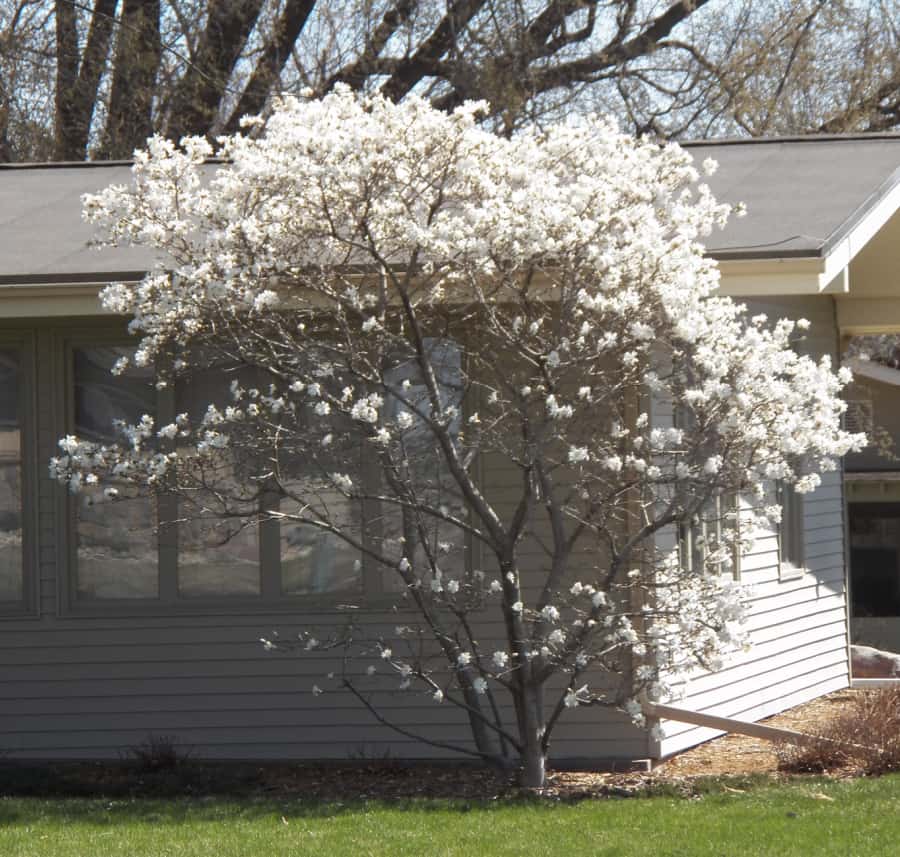
Conclusion
Magnolias bless us each spring with bright and fragrant blossoms, if they do not catch cold. The dark green leaves following the flowers help to make the tree a good addition to any landscape, despite the chance of frost damaged flowers. I hope you add some to your landscape.
Happy planting!




